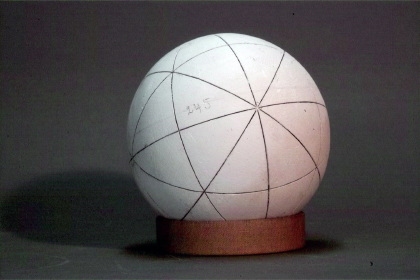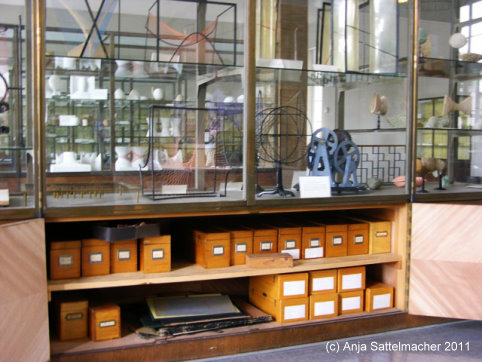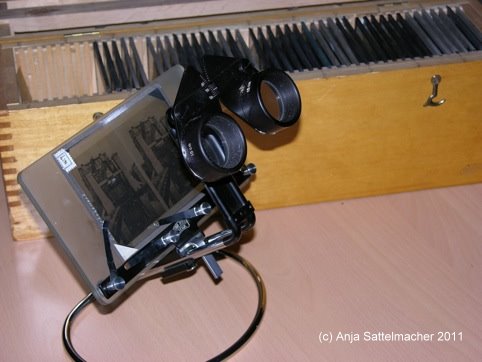- Mathematics
- Historical facts
- Slide collection
 Model 245 in the model collection
Model 245 in the model collection
At the end of the 19. century, the number of students of the subject mathematics at universities and technical universities in Germany dramatically grew bigger. Fully occupied lecture halls initiated structural changes most importantly in the education of descriptive geometry. Drawings at the black board were not equally visible for all the students with a growing number of the audience. Also, a projector was used in mathematical lectures with which illustrations of models or geometrical drawings could be shown to a larger audience. In Göttingen, this development is documented by a large slide collection that was built from approximately 1898 on by Friedrich Schilling who was professor for descriptive geometry. Today, the collection consists of circa 900 glass plates that were partly bought up from professional photographers, partly produced by scientific assistants themselves.

The motives (mainly slide positives and negatives of the format 9 x 12 cm) were thematically assigned in wooden boxes that are intended for these. Its motives range from images of the early plane models to photographs of the Paris world's fair in 1900 to geometrical drawings and illustrations of models.
A seperate class of the slide collection consists of stereoscopic photographs of models and buildings. Two stereoscopically photographed pictures were installed side by side on a glass plate so that they can be viewed three-dimensionally with a projector intended for them. 3D glasses that are still preserved in the collection suggest that the view of stereoscopic model pictures in Göttingen took place despite its complex technique.

The stereoscopies could also viewed with manual stereoscopes that are part of the Göttingen model collection.

The use of a projector established new ways in the use of mathematical models with increasing number of students. Hence, the Göttingen slide collection documents the stages of mathematical visual instruction lectures at around 1900 that moved away from the use of three-dimensional material models to more practical, handy and also cheaper processes for the education of stereoscopic vision. The slide collection permits to use the advantages of a mathematical model for the visual instruction education without having to use the object itself. Therefore, 1904 Schilling suggested the reader of the instructions of his slide collection (and with it colleagues of other institutes and seminars) to use a projector for mathematical education.1 In the Göttingen auditorium hall, where the mathematical institute was housed until 1929, already 1901 extra hitches were installed in the lecture room no. 18 to allow a smooth use of the projection method.2
1: Schilling, Friedrich (1905): Welche Vorteile gewährt die
Benutzung
des Projektionsapparates im mathematischen Unterricht?
(Which advantages does the use of a projector grant in mathematical education?)
In: A. Krazer (Hg.):
Verhandlungen des 3. Internationalen Mathematiker-Kongresses in Heidelberg vom
8. bis 13. August 1904. Leipzig: Teubner, S. 751-755, here: p. 755
2: Cf. die Nachlassakte Felix Kleins (the deceased's file of Felix
Klein): SUB Universität
Göttingen HSD, Cod. MsFKlein2C.
anja.sattelmacher@hu-berlin.de